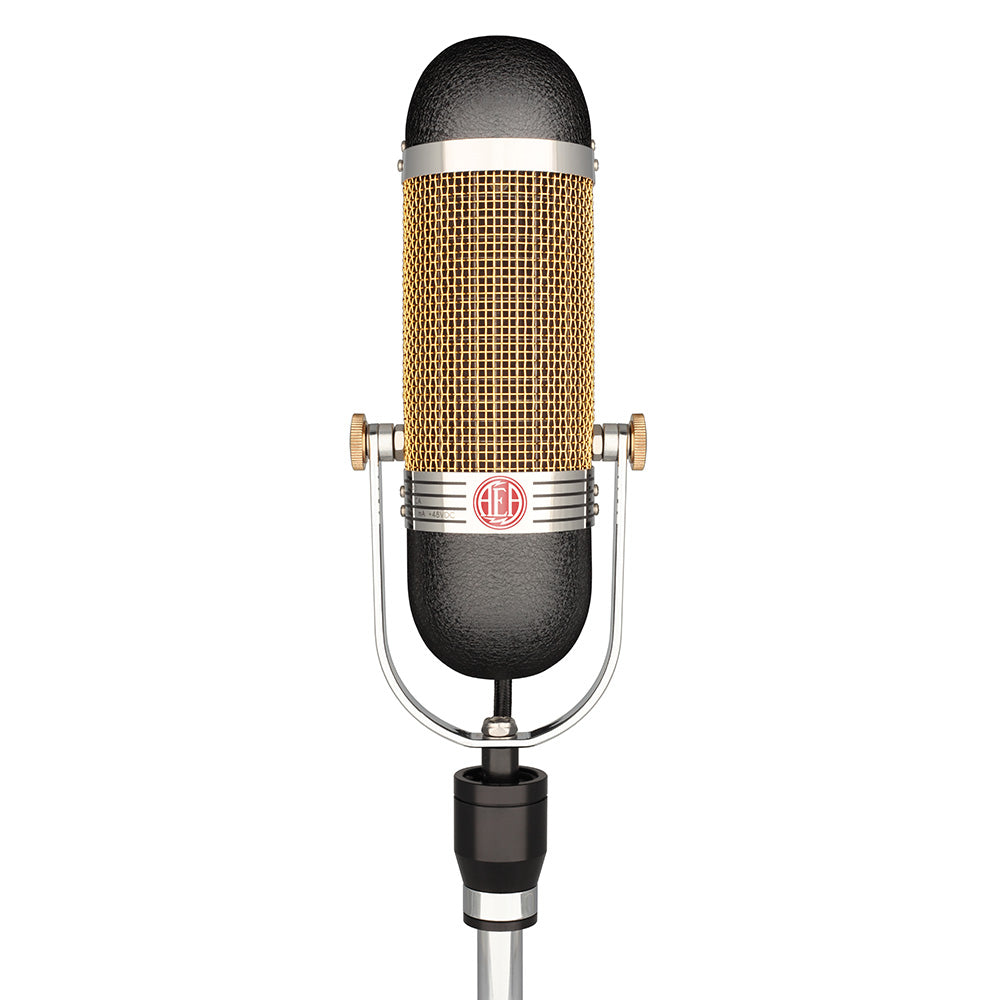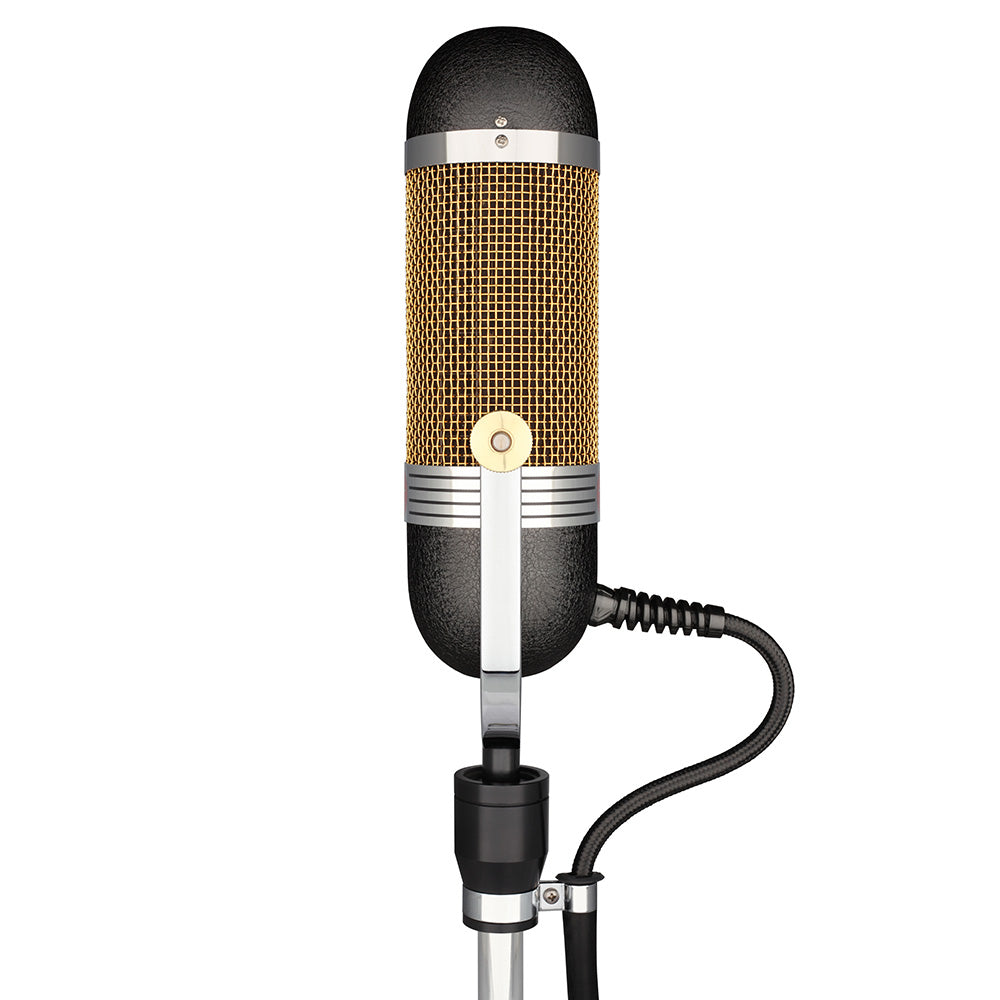
Description
The R84A delivers the same award-winning sound as its passive sibling, the R84. Its higher output and immunity to impedance-loading offer more flexibility in the choice of preamps, and avoid noise problems in low signal level applications. Touring musicians who are looking for consistent and risk-free performance in a wide range of venues and recording setups will find a trusty companion in the R84A microphone. The R84A remedies most of the limitations of passive ribbon microphones, whether in a remote recording situation with long cable runs, a classical music application, or simply for the wish to combine the ribbon sound with a low-gain vintage preamp. The signal strength and flexibility of active JFET electronics combined with the luxurious warmth of a Big Ribbon™ all wrapped up in an affordable package is what sets this microphone apart. No studio is complete without a pair of R84As.
Features:
- Phantom powered R84 with 12 dB more sensitivity
- Custom German toroidal transformer and JFET electronics
- Optimal for soft sound sources and classical recording
- Same award-winning sound as the passive R84
Classic Sound Meets Cutting Edge Technology
Building on the success of the R84 and the legacy of the RCA designs, the R84A marks the next step in incorporating the same modern JFET electronics and high performance transformer as used in AEA's flagship active microphone, the A440. Back in the RCA days, ribbon microphones were always passive transducers. With the invention of transistors and the subsequent reduction in size of electronic components, it has become possible to use ribbon mics in even more applications. A passive ribbon microphone needs to be matched with a high gain, high impedance preamp, like AEA's TRP or RPQ, to achieve its best performance. Phantom-powered, or active, ribbon microphones like the R84A can be used with a wider range of preamps, including those commonly found in USB or Firewire audio interfaces. Does this mean that passive ribbons are an obsolete relic of the past? Absolutely not: Passive ribbon microphones still have an edge when it comes to maximum signal level (165 dBSPL instead of 134 dBSPL), the more minimalist signal path, and lower cost.
A Big Ribbon for a Big Sound
The AEA R84A uses a big, 2.35" by 0.185" by 2 micron pure aluminum low-tension ribbon element just like the classic R44. Many ribbon mic manufacturers choose shorter ribbons that are easier to install, but AEA's Large Ribbon Geometry TM design offers important advantages. Ribbon microphones operate linearly above their resonant frequency, unlike condenser or moving-coil transducers, so the resonant frequency of a good microphone design should be as low as possible. The longer the ribbon, the lower the resonant frequency will be. The ribbon has to move twice as far for every drop in octave as it vibrates within the magnetic gap, thus a longer ribbon will allow for further movement back and forth. This results in the ribbon handling louder sound sources and more sound pressure level (SPL). Most AEA ribbons are tuned to 16.5 Hz, and because the R84A shares the same Big Ribbon™ as the rest of AEA's product line, you will achieve a sound that is smooth, natural and free from any of the uncomfortable resonances that shorter ribbons and condensers can exhibit. The result is a sound that many engineers say is astonishingly close to what their ears hear when you're actually standing in the studio.
| Operating Principle | Pressure gradient microphone |
| Directional Pattern | Bidirectional (Figure-of-8) |
| Frequency Range | 20 Hz to 20 kHz |
| Maximum SPL | 141+ dBSPL (1% third harmonic> 1 kHz) |
| Output Sensitivity | 6.3 mV/Pa (-44 dBV) into unloaded circuit |
| Self Noise | 17.5 dB(A) |
| Output Impedance | 92 ½ broadband |
| Recommended Load Impedance | 1.0 k½ or greater |
| Powering | P48 phantom power, 7 mA |
| Polarity | Pin 2 high for positive pressure on front of microphone |
| Connector | XLR-3M wired to a 3 m captive cable |
| Off Axis Response | |
| Polar Pattern | Native bi-directional pattern |
| Horizontal | Level changes with angle, frequency response is consistent, Ð35 dB null at 90¡ / 270¡ |
| Vertical | Level changes with angle, reduced HF response above and below 0¡ / 180¡ axis, Ð35 dB null at 90¡ / 270¡ |
| Transducer element | |
| Ribbon Thickness | 1.8 _ (0.0000018 m) of pure aluminum |
| Ribbon Width | 0.185Ó (4.7 mm) |
| Ribbon Length | 2.35Ó (59.7 mm) |
| Accessories | |
| Included | Custom storage / shipping case, manual |
| Optional | Any length cable, inquire for price and delivery |
| Limited Warranty | One year parts and labor, shipping not included. Three year extended warranty if the product is registered. |
| Weight with Cable | 3 lb 11 oz (1.7 kg) in storage case with cable |
| Dimensions | Height: 11.6Ó (29.5 cm) Width: 3.9Ó (9.9 cm) Depth: 2.5Ó (6.4 cm) |
The R84A delivers the same award-winning sound as its passive sibling, the R84. Its higher output and immunity to impedance-loading offer more flexibility in the choice of preamps, and avoid noise problems in low signal level applications. Touring musicians who are looking for consistent and risk-free performance in a wide range of venues and recording setups will find a trusty companion in the R84A microphone. The R84A remedies most of the limitations of passive ribbon microphones, whether in a remote recording situation with long cable runs, a classical music application, or simply for the wish to combine the ribbon sound with a low-gain vintage preamp. The signal strength and flexibility of active JFET electronics combined with the luxurious warmth of a Big Ribbon™ all wrapped up in an affordable package is what sets this microphone apart. No studio is complete without a pair of R84As.
Features:
- Phantom powered R84 with 12 dB more sensitivity
- Custom German toroidal transformer and JFET electronics
- Optimal for soft sound sources and classical recording
- Same award-winning sound as the passive R84
Classic Sound Meets Cutting Edge Technology
Building on the success of the R84 and the legacy of the RCA designs, the R84A marks the next step in incorporating the same modern JFET electronics and high performance transformer as used in AEA's flagship active microphone, the A440. Back in the RCA days, ribbon microphones were always passive transducers. With the invention of transistors and the subsequent reduction in size of electronic components, it has become possible to use ribbon mics in even more applications. A passive ribbon microphone needs to be matched with a high gain, high impedance preamp, like AEA's TRP or RPQ, to achieve its best performance. Phantom-powered, or active, ribbon microphones like the R84A can be used with a wider range of preamps, including those commonly found in USB or Firewire audio interfaces. Does this mean that passive ribbons are an obsolete relic of the past? Absolutely not: Passive ribbon microphones still have an edge when it comes to maximum signal level (165 dBSPL instead of 134 dBSPL), the more minimalist signal path, and lower cost.
A Big Ribbon for a Big Sound
The AEA R84A uses a big, 2.35" by 0.185" by 2 micron pure aluminum low-tension ribbon element just like the classic R44. Many ribbon mic manufacturers choose shorter ribbons that are easier to install, but AEA's Large Ribbon Geometry TM design offers important advantages. Ribbon microphones operate linearly above their resonant frequency, unlike condenser or moving-coil transducers, so the resonant frequency of a good microphone design should be as low as possible. The longer the ribbon, the lower the resonant frequency will be. The ribbon has to move twice as far for every drop in octave as it vibrates within the magnetic gap, thus a longer ribbon will allow for further movement back and forth. This results in the ribbon handling louder sound sources and more sound pressure level (SPL). Most AEA ribbons are tuned to 16.5 Hz, and because the R84A shares the same Big Ribbon™ as the rest of AEA's product line, you will achieve a sound that is smooth, natural and free from any of the uncomfortable resonances that shorter ribbons and condensers can exhibit. The result is a sound that many engineers say is astonishingly close to what their ears hear when you're actually standing in the studio.
| Operating Principle | Pressure gradient microphone |
| Directional Pattern | Bidirectional (Figure-of-8) |
| Frequency Range | 20 Hz to 20 kHz |
| Maximum SPL | 141+ dBSPL (1% third harmonic> 1 kHz) |
| Output Sensitivity | 6.3 mV/Pa (-44 dBV) into unloaded circuit |
| Self Noise | 17.5 dB(A) |
| Output Impedance | 92 ½ broadband |
| Recommended Load Impedance | 1.0 k½ or greater |
| Powering | P48 phantom power, 7 mA |
| Polarity | Pin 2 high for positive pressure on front of microphone |
| Connector | XLR-3M wired to a 3 m captive cable |
| Off Axis Response | |
| Polar Pattern | Native bi-directional pattern |
| Horizontal | Level changes with angle, frequency response is consistent, Ð35 dB null at 90¡ / 270¡ |
| Vertical | Level changes with angle, reduced HF response above and below 0¡ / 180¡ axis, Ð35 dB null at 90¡ / 270¡ |
| Transducer element | |
| Ribbon Thickness | 1.8 _ (0.0000018 m) of pure aluminum |
| Ribbon Width | 0.185Ó (4.7 mm) |
| Ribbon Length | 2.35Ó (59.7 mm) |
| Accessories | |
| Included | Custom storage / shipping case, manual |
| Optional | Any length cable, inquire for price and delivery |
| Limited Warranty | One year parts and labor, shipping not included. Three year extended warranty if the product is registered. |
| Weight with Cable | 3 lb 11 oz (1.7 kg) in storage case with cable |
| Dimensions | Height: 11.6Ó (29.5 cm) Width: 3.9Ó (9.9 cm) Depth: 2.5Ó (6.4 cm) |
Your home for all things pro audio—backed by expertise and experience. Connect with us today.
Your home for all things pro audio—backed by expertise and experience. Connect with us today.



